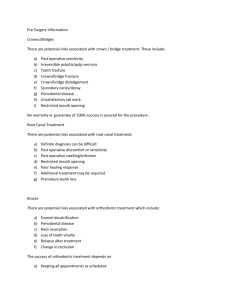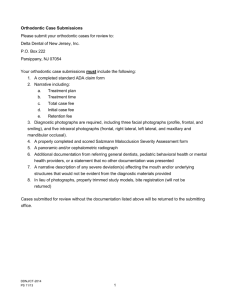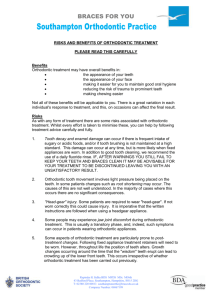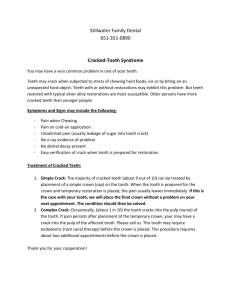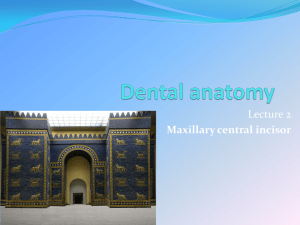An Unerupted Dilacerated Permanent Maxillary left Central incisor
advertisement
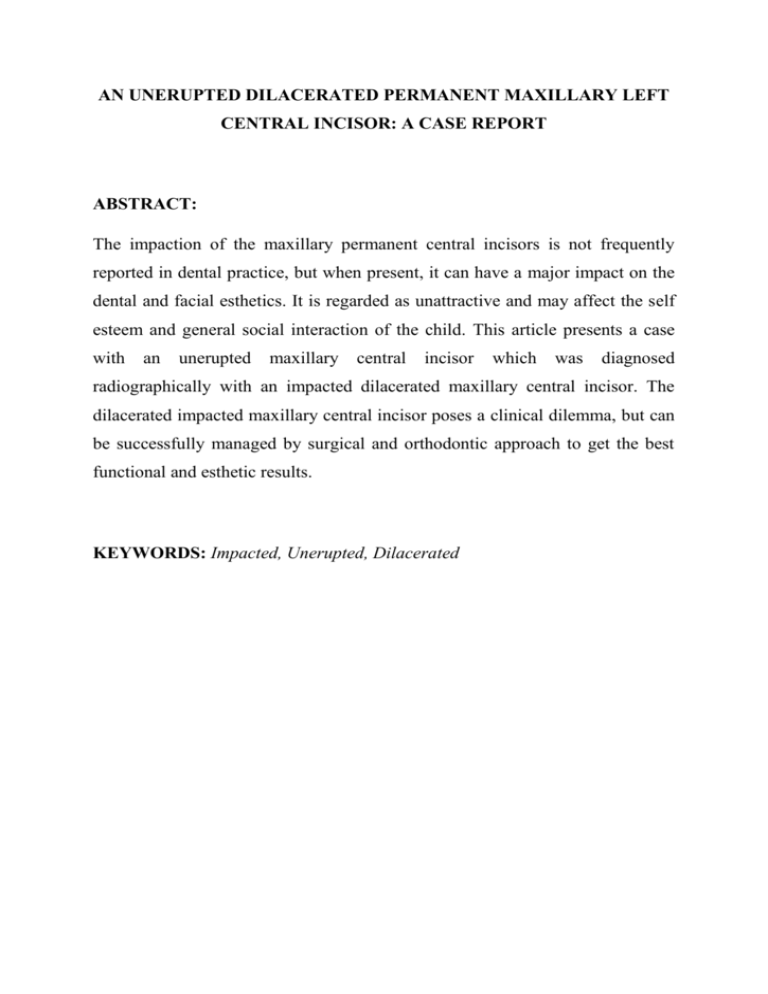
AN UNERUPTED DILACERATED PERMANENT MAXILLARY LEFT CENTRAL INCISOR: A CASE REPORT ABSTRACT: The impaction of the maxillary permanent central incisors is not frequently reported in dental practice, but when present, it can have a major impact on the dental and facial esthetics. It is regarded as unattractive and may affect the self esteem and general social interaction of the child. This article presents a case with an unerupted maxillary central incisor which was diagnosed radiographically with an impacted dilacerated maxillary central incisor. The dilacerated impacted maxillary central incisor poses a clinical dilemma, but can be successfully managed by surgical and orthodontic approach to get the best functional and esthetic results. KEYWORDS: Impacted, Unerupted, Dilacerated INTRODUCTION: Impaction is the total or partial lack of eruption of a tooth well after the normal age of eruption [1] . Several factors have been suggested that impede tooth eruption. Most common factors associated with impacted teeth include supernumerary teeth in anterior maxillary region [2, 3], odontogenic tumours such as odontomas, cysts [4-6] , alteration in the path of eruption or formation of scar tissue due to trauma or premature loss of primary incisors angulation or dilacerations [8] [7] and abnormal root . The frequency of maxillary central incisor impaction has been found in the range of 0.006 to 0.2% [9]. The dilaceration is characterized by an angulation in the crown and root of the tooth. The term dilacerations was first used by Tomes. Dilaceration has been coded as ICD-9-CM 5204(a) based on the international classification of diseases-9th revision-clinical modification. This dilaceration is often related to the trauma from primary central incisors during early developmental stages of the permanent central incisors [10]. This article presents a case report of management of a dilacerated and impacted right maxillary central incisor in an eleven year old male patient. A CASE REPORT: A male patient aged eleven years reported to the Department of Pediatric & Preventive Dentistry, Rama Dental College, Hospital & Research centre, Kanpur (U.P.), [Figure 1] with a chief complaint of space in upper anterior region & pain in anterior portion of floor of nose. The child was physically healthy and had no history of dental and medical trauma. Intra oral examination revealed mixed dentition with Class I molar relationship. There was a missing permanent maxillary left central incisor (21). [Figure 2] A palpable bulge was observed in anterior part of hard palate which suggested that a missing tooth was impacted towards the palatal side. [Figure 3] An intraoral periapical radiograph was taken to ascertain the presence & position of missing permanent maxillary left central incisor. The IOPAR showed the ectopic position of unerupted 21. [Figure 4] Occlusal radiograph of maxilla also revealed ectopic position of unerupted tooth. [Figure 5] OPG confirmed the acute bend of root of 21. [Figure 6] Treatment depends on the degree of dilaceration, the relative position of the tooth & the patient’s / parent's motivation. Preferred treatment is surgical exposure & orthodontic traction. In the present case, the dilaceration was so acute that orthodontic traction was not possible, so it was decided to extract the tooth. Prior consent was taken from patient’s parents. Routine presurgical investigations were carried out & surgery was done under local anesthesia. A crevicular incision was made to include two teeth on either sides & a mucoperiosteal flap was raised. [Figure 7.] Bone cutting was done to expose the crown. [Figure 8.] The tooth was extracted with great care. [Figure 9] The follicle of the tooth was enucleated & curettage was done followed by copious irrigation [Figure 11.] & a clear cavity was visible thereafter. Sutures were placed at the end of surgery to promote healing. [Figure 12] . After 1 week sutures were removed. [Figure 13] Missing tooth was replaced by removable acrylic partial denture. DISCUSSION: Dilaceration is a deformity that results from a disturbance in relationship between uncalcified and already calcified portions of a developing tooth [11]. Trauma has been suggested as a main etiological factor [12, 13] , but many studies have found no history of trauma in some cases of dilacerations. As dilacerations have also been observed in teeth with no predecessors, hence ectopic development of tooth germs too is considered to be causative cause. In addition, only a single central incisor is usually dilacerated; if trauma were the sole contributing factor, the adjacent incisors would also be expected to be involved. The prognosis of dilacerated teeth is not favorable, as usually all the teeth remain unerupted. As in the present case, the tooth remained unerupted. In this case, orthodontic eruption was not possible because of the acute bend of root & position of the tooth deep in the bone; hence extraction was preferred to prevent unfavorable sequelae of unerupted tooth. CONCLUSION: Diagnosis of dilacerated teeth should be made as early as possible so that if extraction of dilacerated tooth is to be planned then either the space can be closed by orthodontic means or can be kept as such until the patient becomes mature enough for definitive implants or prosthodontic treatments. REFERENCES: 1. Orthodontic glossary. Orthodontics; 1993. St Louis: American Association of 2. Giancotti A, Grazzini F, De Dominicis F, Romanini G, Arcuri C. Multidisciplinary evaluation and clinical management of mesiodens. J Clin Pediatr Dent 2002; 26:233-7. 3. Ibricevic H, Al-Mesad S, Mustagrudic D, Al-Zohejry N. Supernumerary teeth causing impaction of permanent maxillary incisors. J Clin Pediatr Dent 2003; 27:327-32. 4. Batra P, Duggal R, Kharbanda OP, Parkash H. Orthodontic treatment of impacted anterior teeth due to odontomas: a report of two cases. J Clin Pediatr Dent 2004; 28:289-94. 5. Kamakura S, Matsui K, Katou F, Shirai N, Kochi S, Motegi G. Surgical and orthodontic management of compound odontoma without removal of the impacted permanent tooth. Oral Surg Oral Med Oral Pathol 2002; 94:540-2. 6. Morning P. Impacted teeth in relation to odontomas. Int J Oral Surg 1980; 9:81-91. 7. Avinash K, Aieshya F. Impacted maxillary central incisors and over retained deciduous central incisors: Combined surgical and orthodontic treatment – A case report. J Int Oral Health 2011; 3[3]:2530. 8. Stewart DJ. Dilacerated unerupted maxillary central incisors. Br Dent J 1978; 145:229-33. 9. Grover PS, Lorton L. The incidence of unerupted permanent teeth and related clinical cases. Oral Surg Oral Med Oral Pathol. 1985; 59: 420– 5. 10. Deshpande A, Prasad S, Deshpande N. Management of impacted dilacerated maxillary central incisor: A clinical case report. Contemp Clin Dent. 2012 April; 3(l1): S37–S40. 11. Hegde C, Hegde M, Paraguli U. Orthodontic repositioning of a malposed and dilacerated central incisor. Kathmandu university Medical Journal. 2009; 7[4]: 435-7. 12. Ravn JJ. Sequelae of acute mechanical traumatic in primary dentition: A clinical study. J Dent Child. 1968; 35: 281-9. 13. Howard RD. The congenitally displaced maxillary incisor: A differential diagnosis. Dent Pract. 1970; 20: 361-70. LEGENDS: FIGURE 1: Extraoral view FIGURE 2: Photograph showing missing permanent maxillary left central incisor FIGURE 3: Photograph showing a palpable bulge in the anterior part of hard palate FIGURE 4: Intra oral periapical radiograph FIGURE 5: Occlusal Radiograph FIGURE 6: Orthopantomogram FIGURE 7: Photograph showing Crevicular incision FIGURE 8: Photograph showing exposure of the crown FIGURE 9: Photograph showing the extraction procedure of dilacerated tooth FIGURE 10: Photograph showing the extracted tooth FIGURE 11: Photograph showing the Enucleation and curettage FIGURE 12: Photograph showing the suture placement FIGURE 13: Photograph showing removal of the suture FIGURE 14: Post Operative Photograph showing healing FIGURE 15: Post Operative Orthopantomogram FIGURE 16: Photograph showing Prosthetic replacement of the missing tooth

